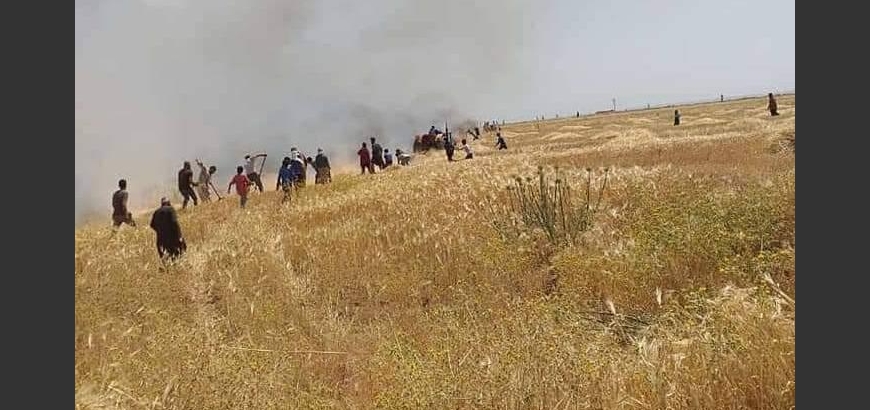The burning of agricultural harvests, and their expansion into various Syrian regions, has recently become a frequent occurrence, especially now that it seems these fires are not accidental, but are being used as a weapons, as has recently occurred in some areas.
Burning agricultural harvests is not at all a new phenomenon, but has been a preoccupation for farmers every season. A single cigarette can burn hundreds of hectares of wheat harvests and destroy a whole year’s efforts. Therefore farmers are also making additional efforts during the harvest season to protect their crops from fires.
However in the context of the war Assad is carrying out against the Syrian people, everything has been turned into a weapon ready to be used, meaning that in recent years farmer’s agricultural harvests have been targeted by indiscriminate land and air attacks by Assad’s forces, as part of a policy of blockading areas outside regime control and fighting them economically and using the supply of food as a weapon.
This became very clear over the last few months of the siege of Daraya in the Damascus countryside when the regime used incendiary weapons on crops at some farms, with the aim of destroying them and preventing those under the blockade from harvesting them. This was also used as a weapon by the regime in its war against eastern Ghouta and the northern Homs countryside.
Over the last few weeks, the regime has made it clear that it has developed its use of this weapon and that it is more than just burning harvests, but is a new policy and weapon within the scope of use by the regime and other parties in Syria.
Over the last three days, Alsouria Net has observed the burning of tens of thousands of hectares of farmlands in various Syrian provinces. Warplanes of the regime and its ally Russia have burned broad areas in the Idleb and Hama countrysides.
Thousands of hectares have been burned in Hassakeh province and in the northern Raqqa countryside, while authorities of the “Self-Administration” in the two areas have declared that the burnings were caused by arson.
The fires have consumed broad areas in the western Suweida countryside and the western and eastern Daraa countrysides. There has been no confirmation they were arson, but their timing and the expansion of their scope suggests they were not accidental.
Observers estimate that the losses of the agricultural sector in Syria have gone into the billions of Syrian pounds over the past week alone from the intentional or unintentional burnings, regardless of who militarily controls the area in which the fires occur.
These major losses are expected to push responsible agencies in each area to compensate for the losses with imports from outside and that residents will suffer from high prices.
The regime has done this in recent years and the Self-Administration is expected to follow the same path if the amount of agricultural yields fall, especially wheat.
It is likely the scene will replay itself in opposition-controlled areas, leaving the question: Who are actually the losers? Is it the farmers themselves, or the entities that play the role of the state in the areas they control?
This article was translated and edited by The Syrian Observer. Responsibility for the information and views set out in this article lies entirely with the author.


